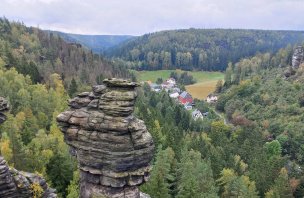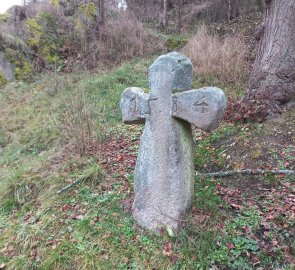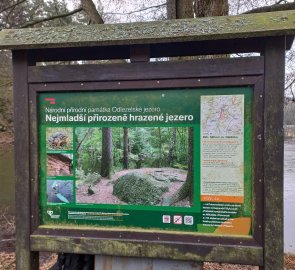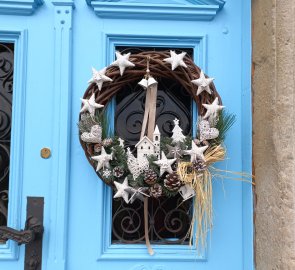Trip to the Horní Střela Nature Park
Mountain range, region / State
/ Czech Republic
Season
Fall
14. 12. 2024
Difficulty
1 / 5
Elevation
↑ 623 m
↓ 624 m
Length
26.4 km
6 hours
Altitude
max. 605 m n.m.
min. 382 m n.m.
Tips for hikes in the country Czech Republic

Autumn trip to Peperek hill in Highlands

Trip to Hercules Columns in the Sachsen Switzerland

Trip to the Podvrší lookout tower and Blansek Castle
A trip to see the history and natural beauty around the village of Žihle
Starting point
Square in the village Žihle, parking is free.
Description of the hike
I leave the car at the square in Žihla and follow the yellow trail from the railway station into the forest. After a while, granite boulders and rocks start to appear. After a few smaller ones I come to a huge round Grandfather and a little behind him is Babka, which the frost has decorated with icicle lace. There are countless stone still lifes, the experience is crowned by a double wigwam about a kilometre away.
In the village of Nový dvůr I change the yellow for blue and pass an abandoned castle and a game preserve with horses and white deer and climb gently up a dirt road. Then it is about half an hour through the forest and a short but nutritious climb up the serpentine path to the viewpoint of the Count's Cross. According to legend, an otherwise docile horse refused to continue its journey during a night ride and its rider - Count Lažanský - had to spend the night here. When he saw in the morning that his faithful horse had saved him from falling off the cliff, he had a cross erected here as a thank you. The view from the lookout offers a nice view of the promontory above the Střela River, on which the Baroque chateau and the parish church stand.
After resting for a while, I walk down the same path and upstream of the Strela I reach an old stone bridge. After that I reach a small town, which was once described as the smallest town in the Czech Republic. Before the war, however, Rabštejn was predominantly German and was called Rabenstein an der Schnella, which is said to translate to raven stone. Several half-timbered houses or the monument to the victims of the Great War, Unseren Helden (To Our Heroes, 1914-1918), are reminders of German history. On the way from the bridge, notice the preserved reconciliation cross (baby) with the year 1584. From the parish church, walk down past the old Jewish cemetery back to the river. Rabenstein joined the Sudetenland in 1939, the Czech population was evicted and the two worlds were separated by a line of trenches following the valley of the Střela.
I follow the green trail through a deep valley. The river flows here briskly, sometimes overcoming small ravines, flowing between rocks. The character of the valley is disturbed by strange twisted trees, growing almost horizontally. Only after a while do I realise that these are faded apple trees that used to grow along the millrace, and the flat piece of land in front of it was probably a small field. I'm in front of the former Goat Mill. There is a story about a miller who was killed at the mill (see Trivia). I spend some time in the woods looking for a reconciliation cross from 1720, not easy to find in the overgrown terrain, but I eventually succeed. From the cross, up the hill, along the forest paths past the shooting range and along the dirt paths further back towards Žihla. It is also worth mentioning the picturesque Odlezel Lake, which was created 150 years ago by a landslide and damming of the Mladonice stream. From there it is about 3 km back to Žihla.
Difficulty
The route mostly follows marked hiking trails, dirt and forest paths, there are no dangerous sections.
Water availability
Refreshments are available in Žihla or in Rabštejn.
Mountain peaks
The route does not lead over any peak. Views are offered by the viewpoint Hraběcí kříž, from where you can see the surroundings of the Rabštejn nad Střelou ruin.
Danger
The route is not dangerous, the forest is being logged after a bark beetle calamity, there may be limited passage in some places (2024).
Food
Refreshments are available in Žihla or Rabštejn, but quite limited outside the season. Therefore it is good to have your own snacks.
Attractions
The tale of the killed miller from Kozičkov mill
Farmers from the surrounding area used to come to Kozičkov Mill with grain. When the farmer from nearby Hluboká arrived, there were already several millers in front of him. He didn't want to wait, so he emptied the grain for milling and returned home. After a few days he sent his daughter to see if the grain had been threshed. The girl was walking through the woods on the way and heard voices. When she went to look closer, she saw a miller in the forest surrounded by men. They argued, the argument turned into shouting, and suddenly one of the men raised his gun, fired, and killed the miller. A scream gave the girl away and a run for her life began. The men chased her to the mill where she hid in the ice house and then ran on to her sister who lived across the river. After some time the girl went to a party and a young man who seemed familiar to her began to come for her. She danced with him, and the young man lured her out, until the girl realized with horror that he was one of the men who had killed the miller. She ran straight to the mayor, but before he could round up the man, the young man disappeared and never appeared again. Whether the miller had tricked the man or whether they were robbers was never found out. A cross of reconciliation stands in the woods near the mill to commemorate the horrific event.






















